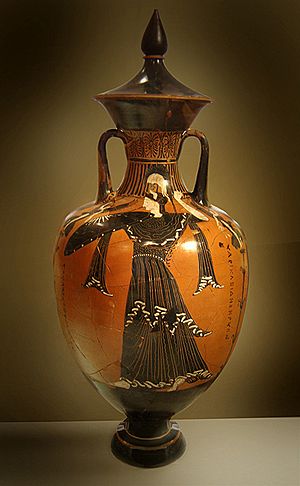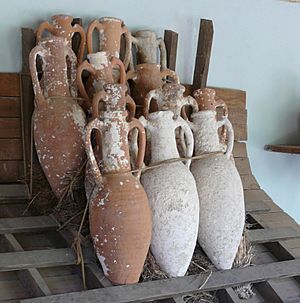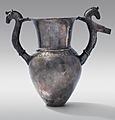Amphora facts for kids

Imagine a tall, ancient jar with two handles! That's an amphora. People in Ancient Greece and Ancient Rome used these special containers to carry things like water, wine, olive oil, or even grain. Amphoras always had two handles, making them easier to lift and carry.
Amphoras came in many different sizes. Some were small, holding about 5 litres, while others were very large, holding up to 50 litres! They were usually made from clay, but sometimes they were made of metal. Big cargo ships that carried liquids across the seas were often packed full of amphoras.
Most of the amphoras we find today were made during the times of Ancient Greece and Ancient Rome. However, these cool jars have been around for a very long time! Some amphoras are as old as 4500 BCE, which means they were made over 6,500 years ago. They have also been found in other places, like ancient China.
Contents
What are Amphoras?
Amphoras are a type of jar with a unique shape. They have a narrow neck, a wide body, and a pointed or flat bottom. The two handles on the sides are a key feature. This design made them strong and easy to transport, especially on ships.
Why were Amphoras so Important?
Amphoras were like the plastic bottles or cardboard boxes of the ancient world. They were essential for trade and everyday life. Without them, it would have been much harder to move food and drinks from one place to another. They helped ancient civilizations grow and connect with each other through trade.
How were Amphoras Made?
Most amphoras were made from clay. Potters would shape the clay on a potter's wheel. After shaping, the amphoras were fired in a very hot oven, called a kiln. This process made the clay hard and waterproof. Sometimes, they were decorated with paintings or designs.
Discovering Ancient Amphoras
Today, archaeologists often find amphoras during excavations. Many are found on land, buried in ancient cities. Even more are discovered underwater in shipwrecks! When a ship sank, its cargo of amphoras would often remain preserved on the seabed.
What can Amphoras Tell Us?
Finding amphoras helps historians learn a lot about the past.
- Trade Routes: The type of clay or the style of an amphora can show where it came from. This helps us understand ancient trade routes.
- Ancient Diets: Sometimes, scientists can find traces of what was inside the amphoras. This tells us what people ate and drank thousands of years ago.
- Daily Life: The sheer number of amphoras found shows how important they were to daily life and the economy of ancient times.
Images for kids
-
Amphora found in Banpo (China), made by the Yangshao culture; 5000–3000 BC; Guimet Museum (Paris)
-
Large late Geometric Attic amphora; 725–700 BC; Louvre (Paris, France)
-
Panathenaic prize amphora for runners; circa 530 BC; terracotta; height: 62.2 cm (241⁄2 in.); Metropolitan Museum of Art (New York City)
-
Greek amphora; 2nd half of the 2nd century BC; glass; from Olbia (Roman-era Sardinia); Altes Museum (Berlin)
See also
 In Spanish: Ánfora para niños
In Spanish: Ánfora para niños








